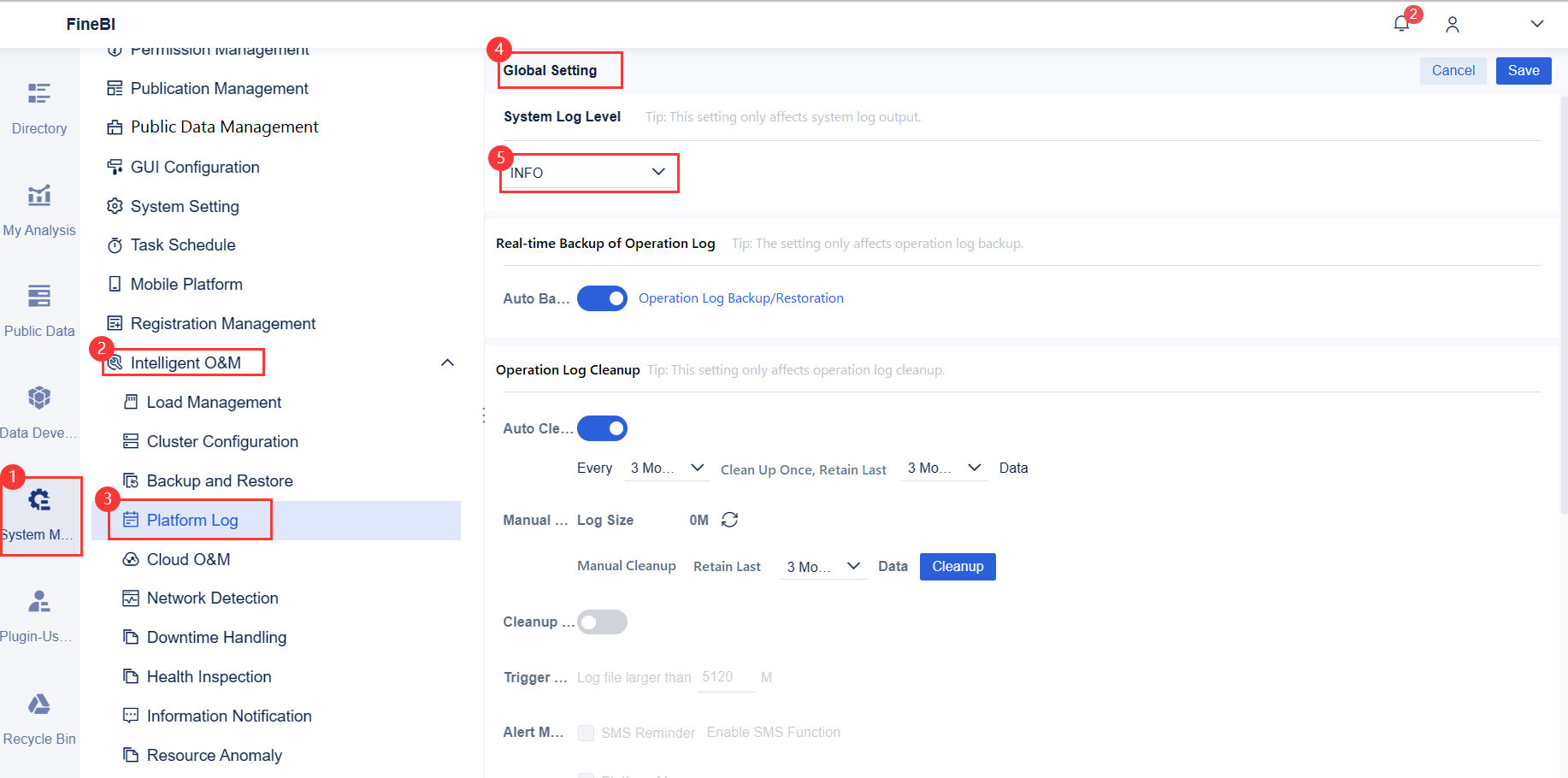Overview
Version
| FineBI Version |
|---|
| 5.1 |
Application Scenarios
To strengthen FineBI project management and monitor project running status at any time, you can enable log recording on the platform, as shown in the following figure.

Function Description
LogDB is the built-in database used to save logs after FineBI log monitoring is enabled. So what are recorded in FineBI logs?
This document briefly introduces meanings of each data table and field in LogDB.
LogDB Connection
New Data Connection
1. Choose System Management > Data Connection > Data Connection Management > New Data Connection as admin, as shown in the following figure.

2. Choose Others > Other JDBC as the data connection method, as shown in the following figure.

3. Configure data connection information, as shown in the following table, and click Save.
| Field | Value | Notes |
|---|---|---|
Data Connection Name | LogDB | / |
Driver | com.fr.swift.jdbc.Driver | Manually enter the drive name. |
Data Connection URL | jdbc:swift:emb://default | Applicable for Mac, Windows, and Linux |

LogDB Data Table Query
 Note:
Note:1. Log in to the decision-making system as admin, and choose System Management > Data Connection > Server Dataset > Create Dataset > SQL Dataset, as shown in the following figure.

2. Enter database query clauses and click Preview to query data tables in LogDB, as shown in the following figure.

Query Syntax
This section briefly introduces the query syntax supported by LogDB. Syntax not listed here is not guaranteed to be available.
Detail Query
SQL clause example:
(1)select * from fine_record_execute
(2) select tname, displayName, consume from fine_record_execute
GROUP BY Query
GROUP BY query support five aggregate functions: SUM, COUNT, MAX, MIN, and AVG.
If no aggregate function is specified in SQL clauses, COUNT will be used by default.
SQL clause example:
(1) select sum(consume) from fine_record_execute group by tname, displayName
(2) select consume from fine_record_execute group by tname, displayName
(same as select COUNT(consume) from fine_record_execute group by tname, displayName)
(3) select min(consume), max(consume) from fine_record_execute group by tname, displayName
WHERE Filter Condition
Simple WHERE filter conditions support AND, OR, =, <>, >, >=, <, <=, in, and isnull.
SQL clause example:
(1) select * from fine_record_execute where consume > 10
(2)select sum(consume) from fine_record_execute where consume > 10 and consume < 100 group by tname, displayName
(3) select consume from fine_record_execute where tname = `doc/Advanced/Chart/GraphSwitching/xxx.frm`
(4) select sum(consume) from fine_record_execute where tname in (`doc/Advanced/Chart/GraphSwitching/xxx.frm`, `doc/Advanced/Chart/Combination/xxx.cpt`) group by tname, displayName
toDate() for Converting Timestamps to Ones of Regular Date Types
toDate() converts timestamps to be ones in the 2018-12-18 10:15:26 format.
SQL clause example:
(1) select todate(time) from fine_record_execute
(2) select * from fine_record_execute where todate(time)<'2018-12-18 10:15:26' and todate(time)>'2018-12-17 10:15:26'
LIKE Clause for Fuzzy Query
Content to be queried needs to be surrounded by % in LIKE clauses.
 Note 1:
Note 1: Note 2:
Note 2:SQL clause example:
select * from fine_record_execute where tname like '%demo%'
FAQs
Update Failed After Tables Are Added to LogDB
Problem:
After tables are added to LogDB, update failed. An error message is displayed on the platform, prompting you to contact the administrator to view the error information because update failed, as shown in the following figure.

Cause:
(1) After the edited base table is updated, nested query occurs, which is not supported by Swift currently. Therefore, operations in the 'Problem' part is not supported in FineBI currently.
(2) LogDB does not support incremental update. LogDB stores internal data, for which external connection is not recommended. If you want to view extracted data, you can adopt full update.
browser Description
The browser field in the fine_record_execute table of LogDB generally records the version (for example: CHROME/83.0.) of the browser used by the client to access reports. For example, if the value of the browser field is as follows:
{'Browser':'webkit','Version':'537.36','Agent':'mozilla/5.0 (windows nt 10.0; win64; x64) applewebkit/537.36 (khtml, like gecko) chrome/81.0.4044.138 safari/537.36','BoxModel':true,'terminal':'null'}
The value recorded is the user agent (browser request header, equivalent to the unique identifier of the browser).
One Template ID Mapping Multiple Template Names
Problem:
In the fine_record_execute table of LogDB, one value specified by reportId maps multiple values specified by tname, as shown in the following figure.

Cause:
If a dashboard renamed multiple times is accessed, exported, or printed, one template ID in the fine_record_execute table maps multiple template names.




